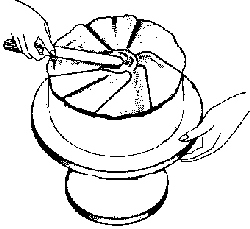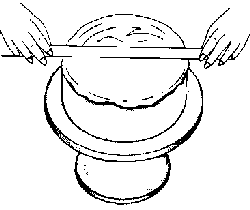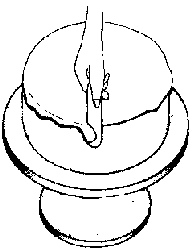How to cover a cake in Royal Icing.
Part 1
presented by Jane from Imaginative Icing
| Below are some easy to follow instructions and illustrations which I found useful when
I was a beginner. I hope you find them of use too and that covering a cake in Royal Icing becomes as easy as spreading butter onto bread. As with most Sugarcraft skills all you need is a little patience and plenty of practice. |

|
|
You will need the following equipment:
|
| 1) Make sure your Royal Icing is
not too stiff or too sloppy, is in a suitable bowl and readily to hand. 2) Place your marzipan covered cake to be iced centrally onto the turn table. 3) Using the palette knife put a large dollop of icing onto the top of the cake and cover the remainder of the icing with the cling film to stop it from drying out. |
 |
4) Still using the palette knife, spread the dollop of icing evenly
over the top only. Now paddle down the icing for a few moments using a backwards and
forwards movement, turning the cake on the turntable as you go.(see picture on left) The paddling displaces any unwanted air bubbles from the icing. At this point don't worry about any icing spilling over the edges...unless of course it is a flood then do scrape up the torrent. Give the palette knife a clean. |
 |
5) Using the straight edge, Holding it at the two ends start at the
furthest edge away from you....at an angle of 45 degrees to the surface, draw it across
the cake towards your body in one continuous movement, making sure not to press down too
hard. (see picture) Return any icing collected on the straight edge back to the bowl. If you are unhappy with your first attempt scrape off and start again, you can do this as many times as you like whilst the icing is still wet and not crusting, about five minutes max. As long as the first coat is level you're doing fine so far. Clean the straight edge after each attempt. |
 |
6) Using the palette knife, remove any icing from the sides of the
cake but don't return it to the bowl if it has become crusty. (see picture)
7) Leave in a dry atmosphere to harden. The top should be dry enough after two hours to enable icing to be applied to the sides. It is possible to ice the top and sides together, but it is easier to do them one at a time when starting out. |
Next: How do I frost the sides of the Cake?
select any of these wedding links:
|
Send mail to PastryWiz with questions or
comments about this web site. |
|
Featured |